PointLight lumen power
-
Bit of Background: There was a thread on a SketchUp FB page about having to artificially multiply/boost IES lights to get them to show in vray. Now editing an IES file really doesn't make any sense as its real measurements of a real light source. If you're not getting enough light in your scene, you've got the wrong luminaire!
In my book, the only valid multiplier to be applied to IES files is LLF (Light Loss Factor) - but lets leave that for another time...
OK. It got be thinking so I looked at 4 popular renderers handling of physically-based units of light.
I tested: Maxwell, vray, LightUp and TheaThe test was a PointLight (aka Omnilight) source of 1256 Lumen at the center of a 2m box. Each surface is thus 1m away from the source at its nearest point.
The surprising results are vray and Thea seem way off on this - and I guess that would explain why the IES files users are having to manually boost to get them bright enough. Maxwell looks correct as does LightUp (which I knew already because it passes the CIE tests on this).
Its entirely possible I've simply missed a critical setup in vray or Thea as I'm no expert - but I can't see anything obvious. So is this known about?
Adam
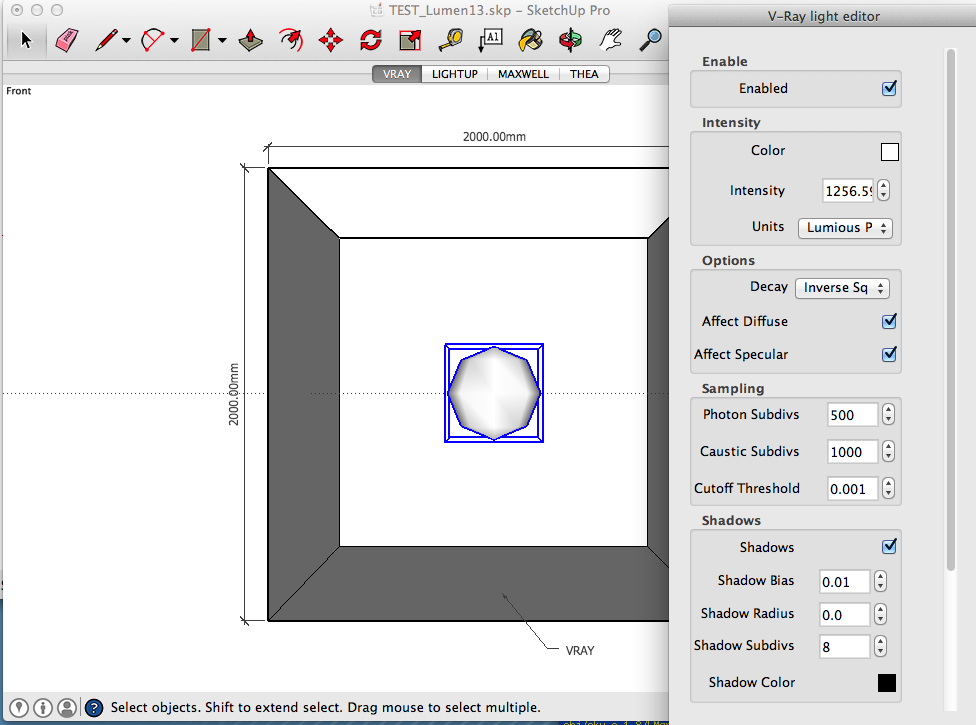

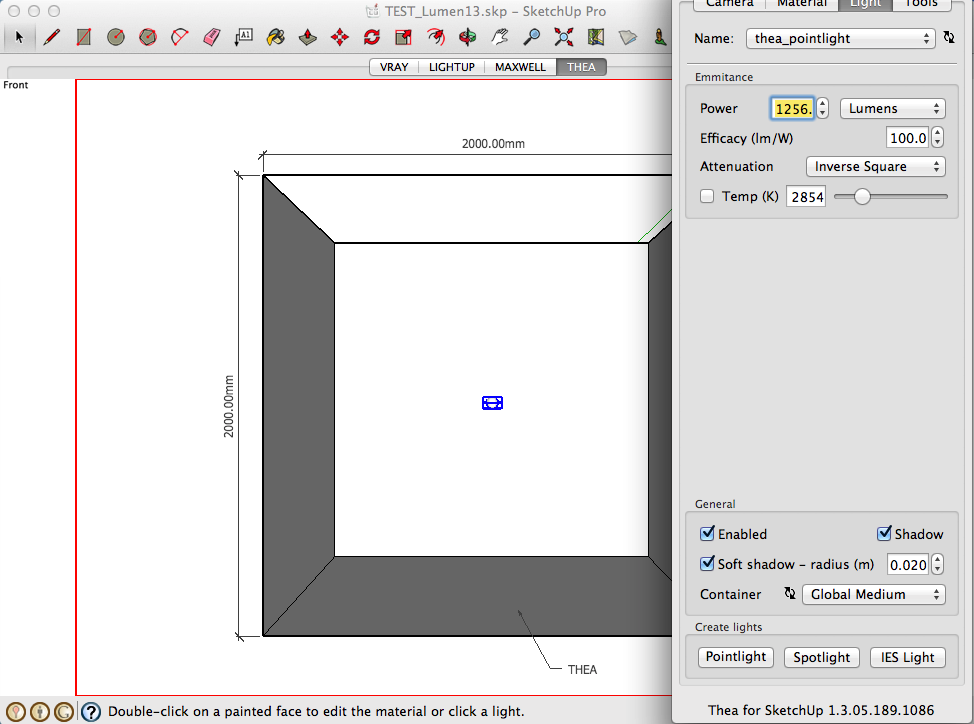
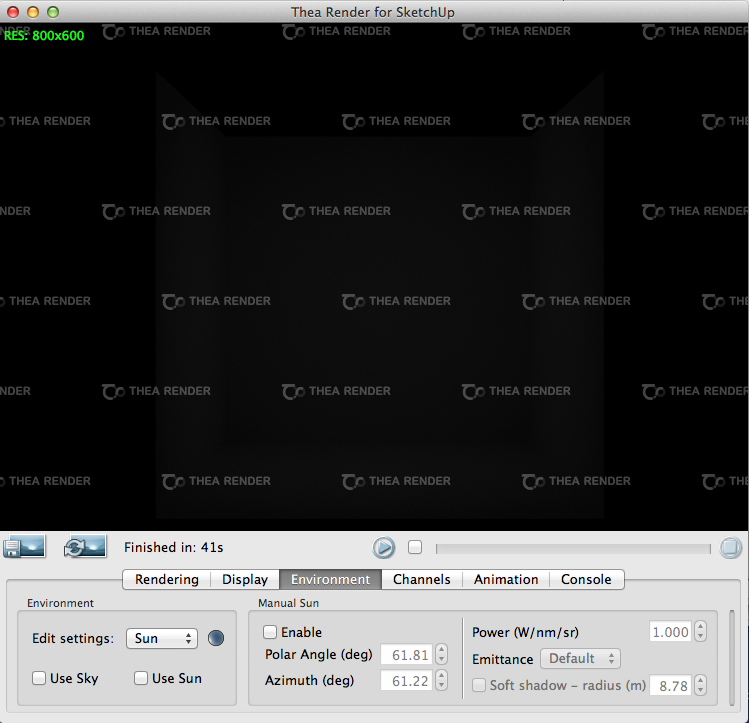
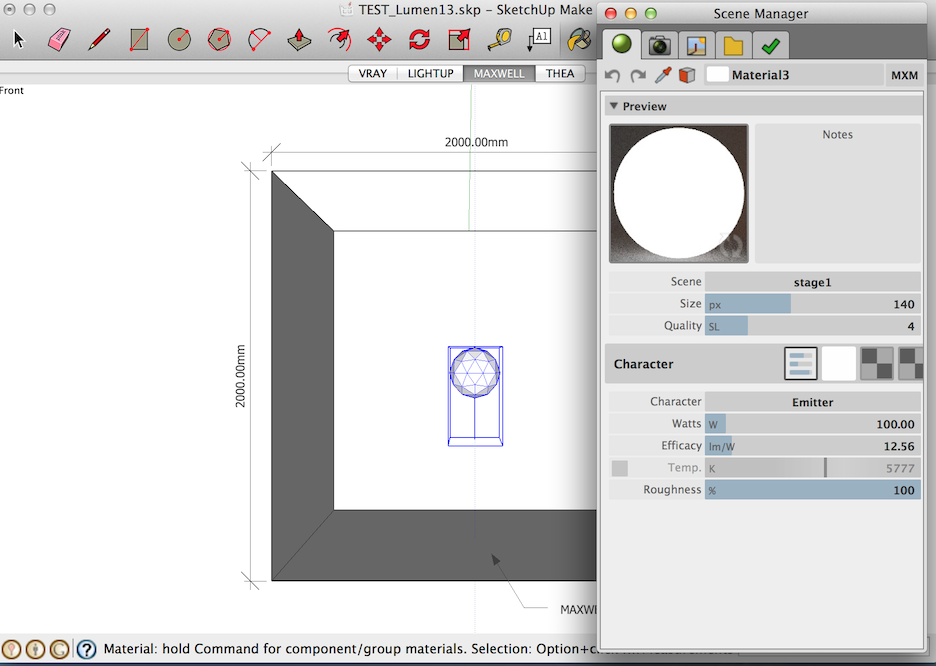

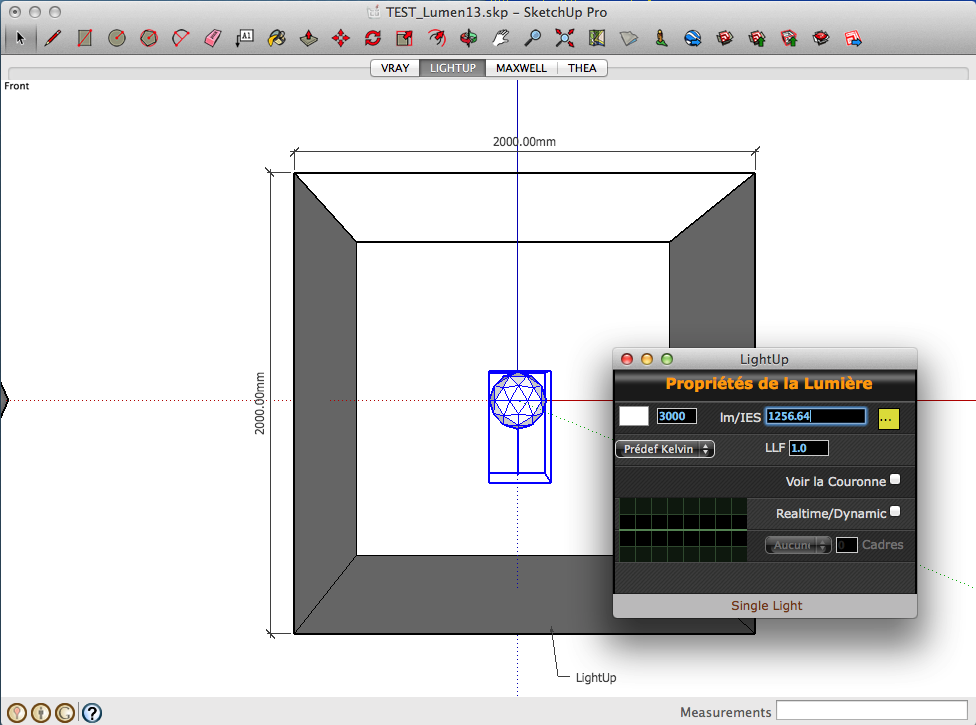
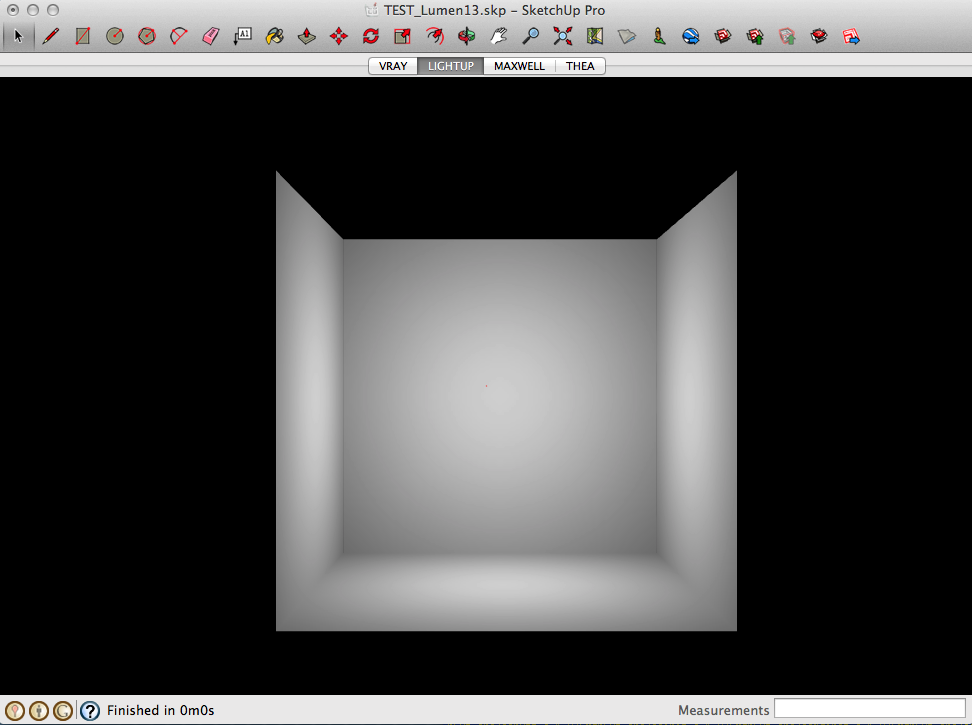
-
Interesting...
Thanks for this comparison
Are all camera settings like ISO, Shutter speed, f-number, brightness and gamma set to the same value?
EDIT: V-Ray version doesn't seem to have softshadows turned on... I wouldn't know how to do it as I'm a Thea user myself...
-
In Thea if you adjust the camera settings (Display Tab) you obtain this:
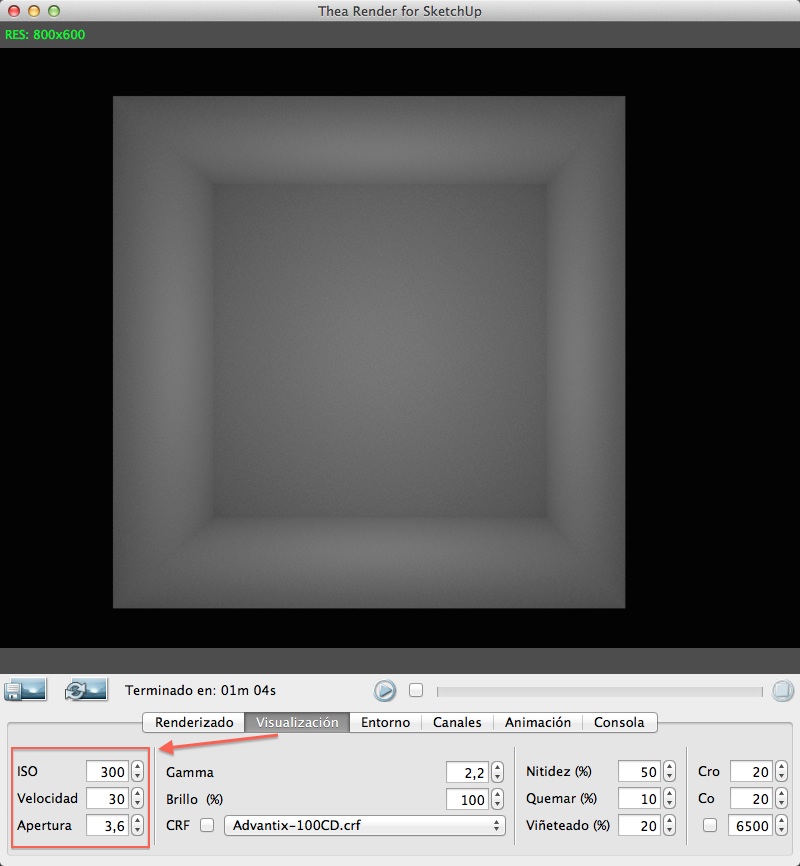
Increasing the ISO and decreasing Shutter and f-number you'll obtain a more lighting image.
-
Thanks for the tip.
So I don't doubt you can multiply up the render to get a brighter output.
My point was that with the standard ISO 100 "film" setting and a 1256 lumen Pointlight (roughly approximate to an old 75 Watt bulb) in a 2m wide box should be pretty well illuminated. Yet it comes out dark..

So the question is why does a 1256 lumen light not illuminate the box as expected?
Adam
-
Thanks for bringing this up Adam. Very interesting.
Does anyone know any good referens values for different lights? -
Like Thea is a physical based engine, the camera settings are identical to the real camera and this is very important in the final result of the render, so to compare the different render applications, you should use the same settings in all, not only the same ISO.
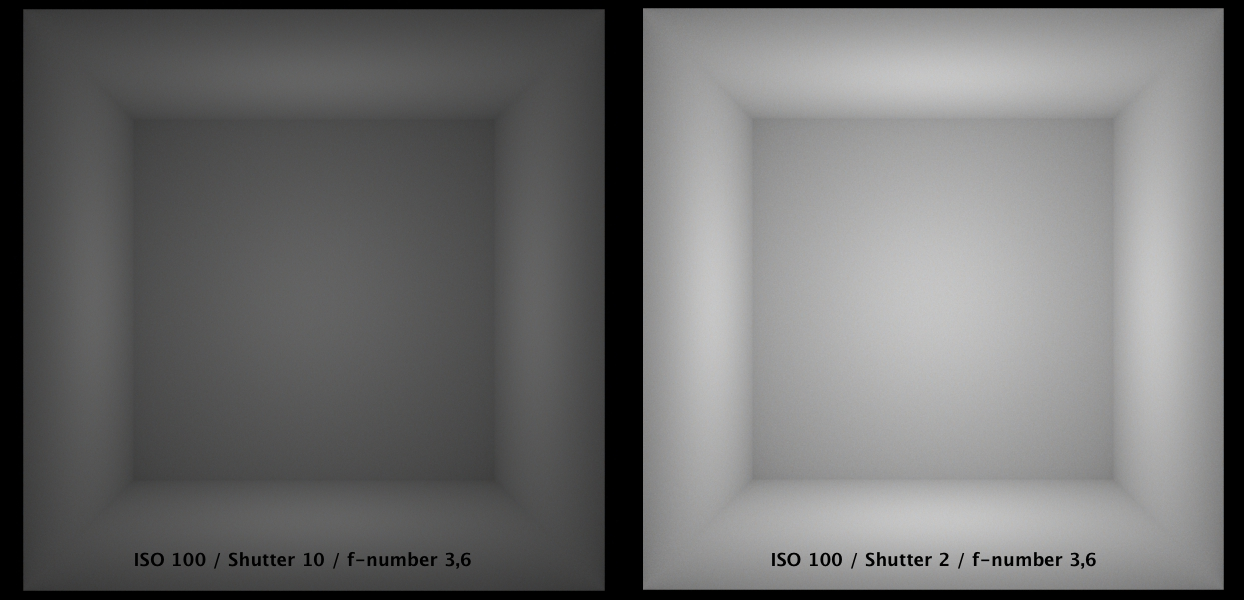
-
@pixero said:
Thanks for bringing this up Adam. Very interesting.
Does anyone know any good referens values for different lights?IES files are definitive because they are real measurements produced in a lab.
The reason for choosing 1256.64 Lumen is this results in precisely 100 lx at 1m away - not my opinion or preference, its just how Physics works.
@oxer said:
Like Thea is a physical based engine, the camera settings are identical to the real camera and this is very important in the final result of the render, so to compare the different render applications, you should use the same settings in all, not only the same ISO.
Surely a 75 Watt bulb in a small box photographed with a real camera loaded with ISO 100 is going to be brightly lit.
So if Thea is a physically-based engine then this is what we should see. Whereas this test appears to give a very dark box which does not match "physically-based cameras" in any way.As I commented, I may well have overlooked something here. But surely "physically-based" rendering engines should give results that are a bit like a physically-based world?

Adam
-
Hi Adam
ISO value alone say nothing. you need to know which f number and shutter speed was used.
here somebody took a photo with 75 watt bulb, look at his exposure settings and try again ... you will see that Thea lightens the 2 meter box
http://www.cryptogon.com/?p=2747 -
Yes, I understand film speed is just one element. However with ISO 100 and some 'regular/default' camera settings of say, f8, 1/16s, I'd expect to see something..
I get if you keep the shutter open for a second, you're going to get a bright result.
I think your link is broken..
-
Giannis (Development Core Thea) wrote in Thea Forum this:
@unknownuser said:
I am writing here the requirements for a correct testing and comparison:
-
Scene scale and geometry must be the same. Light model the same (point light always).
-
Material reflectivity and model must be identical. Selected material model should be Diffuse (everything else varies from renderer to renderer), RGB color set to white (to avoid reverse gamma correction; even better use spectral color for reflectivity).
-
Display settings that matter. Assuming no CRF with brightness=1, gamma=2.2, the following settings must be the same:
- ISO
- Shutter Speed (found in Thea display panel)
- f-Number (found in Thea display panel)
-
-
@oxer said:
Giannis (Development Core Thea) wrote in Thea Forum this:
@unknownuser said:
I am writing here the requirements for a correct testing and comparison:
-
Scene scale and geometry must be the same. Light model the same (point light always).
-
Material reflectivity and model must be identical. Selected material model should be Diffuse (everything else varies from renderer to renderer), RGB color set to white (to avoid reverse gamma correction; even better use spectral color for reflectivity).
-
Display settings that matter. Assuming no CRF with brightness=1, gamma=2.2, the following settings must be the same:
- ISO
- Shutter Speed (found in Thea display panel)
- f-Number (found in Thea display panel)
Sounds good. This is the model I'm using:
TEST_Lumen13.skpA simple empirical test would be to stick a bulb in a 2m box and take a real photo (with known film, f-stop and shutter speed) and compare to the emulation.
-
-
I do believe that you're comparing apples to tomatoes here, AdamB...

You say that the ISO should be 100 and that's about the only information you've provided...
I've yet to see what the f-number and shutter speed is in LightUp, Maxwell and Vray...
These are very important factors when speaking about physically correct render engines...Without such information I can't use your scene for anything...
Besides... I'll claim that I do have the skills to make a 2x2x2 meter box in SU and place a light source in the center of the room...
And a side note...
Why is the light "bulb" in the Maxwell render a big ball...?
If I make a similar ball shape in Thea and apply a emitter material to it using the light values you've informed, then I can get very bright lit rooms in both Thea as well as in Vray... Hence I believe that your comparison fails...I have great respect for what you've done with LightUp over the past few years, but I'm scratching my head to figure why you've posted this thread now...

LightUp is great to use in some cases...
In other cases you'll need a different tool from the tool box (i.e. Thea Render or Vray), which is superior to what LightUp is capable of...
(No offense intended... I'm not being disrespectful here - just honest... As I said, LightUp has some strength in some cases, but weaknesses in others...)You admit that your knowledge about Thea and Vray are limited, yet you're posting this comparison...
Sorry to be so frank here, but I find that a little suspicious - and disrespectful...
What's the point...? -
Hi Frederik (and anyone else), please don't take this thread the wrong way. This is not about showing LightUp to be great / scoring points or whatever. I hope we can have adult technical discussion here.
I was just surprised - as I'm sure others would be - as to why when entering what I thought were reasonable values for f-stop and shutter speed - as in the kind I would use with a real camera - I get such a dark image.
And yes, I realized the Maxwell sphere was making the surface a little (but only a little) closer to the box surfaces.
I'm looking to be educated here. I haven't built a real 2m box and placed a 75 Watt bulb in there - but finger-in-the-air, I would expect it to be quite bright in there.. No? So I was expecting the renderers with physical camera controls to give a result of a brightly lit box.
I see I am mistaken because they're very dark. But why? Can you explain?
Adam
-
what are your camera settings for vray? The default setting in vray is for a sunlit exterior scene. A light bulb in a box is very dim compared to sunlight, and the camera exposure will reflect that.
-
@andybot said:
what are your camera settings for vray? The default setting in vray is for a sunlit exterior scene. A light bulb in a box is very dim compared to sunlight, and the camera exposure will reflect that.
Yes, making the shutter speed 1/4th second brightens it up a lot (and for Thea too), so it looks like thats the problem: the ISO and/or shutter speed multipliers need to be larger.
I guess I'm surprised it would take a quarter second exposure to capture a light bulb.. live and learn.
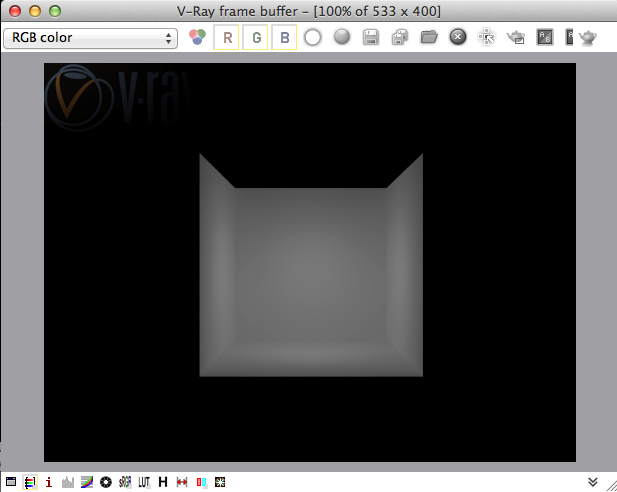
-
Glad you figured it out!

I'm sure you realize there's the third variable - aperture. You're probably at f8, change to smthing like 3, and at iso 400, that shutter speed could probably be 1/60. However, aperture only matters when using DOF, and shutter speed matters for motion blur, otherwise, pick any combination, and you'll get the same EV. That's one thing that's really slick with Maxwell - they have the EV slider which takes the guesswork out of these photographic concepts. -
@adamb said:
I guess I'm surprised it would take a quarter second exposure to capture a light bulb.. live and learn.
Serious... Are you really surprised...???

I recall - in particular from back when we had real film in cameras - that to take a picture inside at night, would require a flash light where the shutter speed needed to be set at 0.3 sec...
If you didn't have a flash light (or didn't want it because of the artificial light appearance), you could:
A.) Use a film with high ISO (I recall up to ISO 2000), but then the penalty would be that the image produced would be very grainy...
(The higher ISO, the more grainy-ness)B.) Increase the exposure time... (Resulting in funny looking images, because motions would be evident)
C.) A combination of A and B
D.) Wait until it became daylight...
Please read the article Patrick posted yesterday...
I know the link seemed broken yesterday, but it works today and contain some wise words about photography, exposure time (shutter speed) etc...
-
Really, the thread creator should have researched a little before making such uninformed comments. Did he even try to take a photo at a totally closed room at night, a single 75 watts lightbulb, ISO 100, shutter speed at 1/60 and F8?
Really, he should have before "guessing" that it should be bright.
"Surely a 75 Watt bulb in a small box photographed with a real camera loaded with ISO 100 is going to be brightly lit."No, it won´t.
Just made tests with my camera. A bedroom in my apartment with 2.8 x 3.3 meters. Two 75 watts lightbulbs. Room totally closed.
At the settings above, that the thread creator "thought" it should be bright, and therefore VRAY and Thea sucked... well, checkout below.
F8, ISO 100
shutter at 1/60
shutter at 1/30

shutter at 1/4

F4, ISO 100
shutter at 1/60
shutter at 1/30

shutter at 1/4

camera used: Canon SX130
ps: sorry for the hanging lamps. That´s the bottom of the ceiling fan. It happens the ceiling fan malfunctioned, so I opened it to see if there was any burned equipment, and somehow I lost the screws

-
Nobody said anything sucked. It simply a question on a forum.
re: your bedroom experiment. Remember its a 1/r^2 falloff so 3m from a source will be 1/9th the power.
-
The source is in the middle of the bedroom. Thus it´s 1,5 meters from the source. So it won´t be 1/9th of the power. Furthermore, there are two 75w lamps, so double the power. Furthermore, the lightball you used to illuminate your scene was larger than my lamps, and closer to the walls. Stop fighting with reality. People asked you again and again to give your shutter and aperture settings and you did not. You would answer just saying you expected any place being lit with a 75w lamp and by using ISO 100 to be brightly lit. I proved that was not true and you still won´t accept?
The truth: Thea and Maxwell are physically correct in your experiments above.
Here, a test a model of my room... same space... same settings as the first photo


you accused Thea and Maxwell of illuminating too little compared with real life. In my test, it shows they actually illuminated too much.
Of course, a REAL REAL test would depend on several other things, like really MODELLING the lamps and getting the real values of emmitance per watt, etc, etc, from the lamp manufacturer. It´s a compact fluorescent lamp, 15W, but the manufacturers and salesman say they are illuminate the same as a 75W incandescent lightbulb.
Having watts alone is not enough, we need watts AND efficacy, and probably also temperature color in kelvin.
but one thing is certain from the tests... even not modelling the real lamps, Thea and Maxwell results are much closer to real life results.
Advertisement







